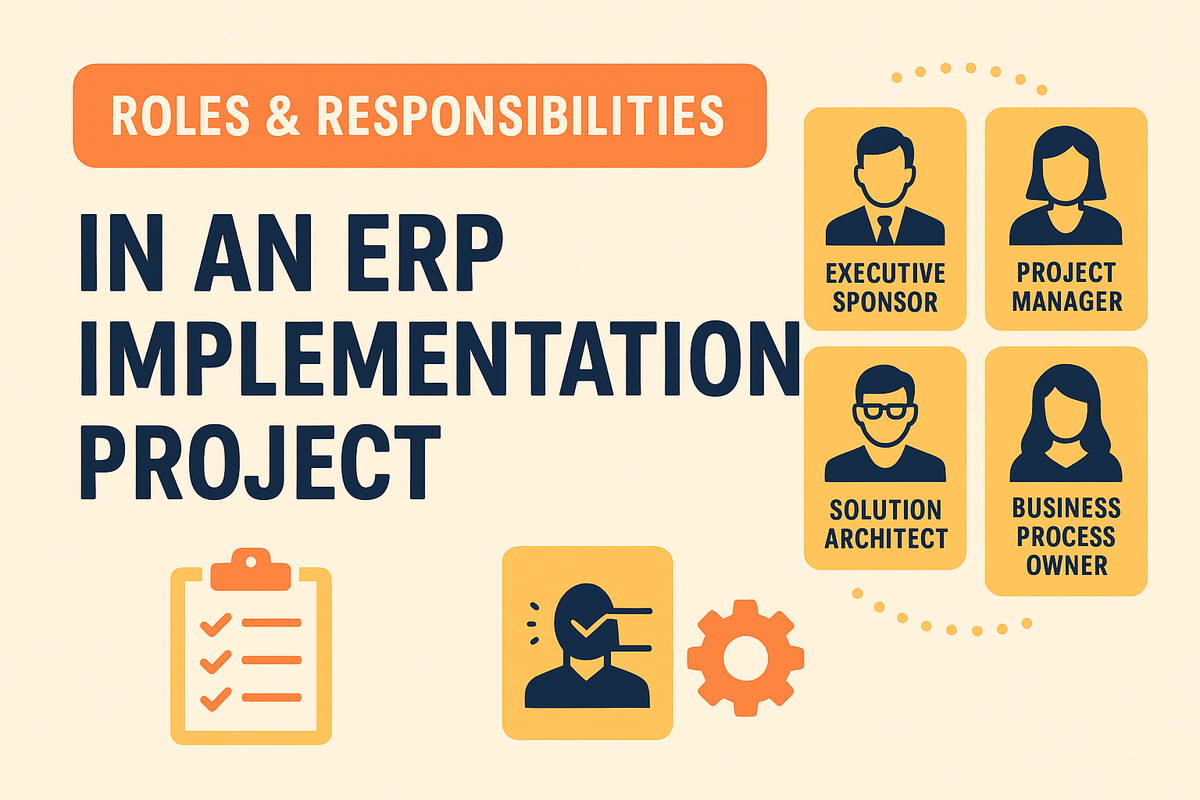Roles & Responsibilities in an ERP Implementation Project

Implementing an ERP system is not just an IT exercise — it’s a full-scale business transformation.
When roles are unclear, projects stall, decisions drag, and adoption suffers.
When they’re well-defined, you get accountability, speed, and alignment.
For a full overview of the ERP journey, see: ERP Implementation Journey — Design to Go-Live
https://www.fitgapfinance.com/erp-implementation-journey-design-to-go-live/
Below is a breakdown of the key roles you need on an ERP project and the responsibilities that come with them.
1. Executive Sponsor
Role: Senior leader providing strategic direction and authority.
Responsibilities:
• Champion the project at the executive level.
• Secure and protect the budget.
• Remove high-level roadblocks.
• Approve major scope or policy changes.
2. Steering Committee
Role: Governance group for strategic oversight.
Responsibilities:
• Monitor alignment with organizational goals.
• Approve critical decisions and milestone sign-offs.
• Resolve escalated conflicts.
3. Project Manager (Client-Side)
Role: Day-to-day leader from the organization’s side.
Responsibilities:
• Manage schedule, scope, budget, and risks.
• Coordinate between business units and the vendor.
• Keep stakeholders engaged and informed.
4. Implementation Partner Project Manager
Role: Leads the consulting/vendor delivery team.
Responsibilities:
• Assign and coordinate technical/functional resources.
• Ensure deliverables meet contractual obligations.
• Manage changes and escalate risks to the client PM.
5. Solution Architect
Role: The “big picture” designer of the ERP solution.
Responsibilities:
• Translate business requirements into a cohesive architecture.
• Ensure seamless integration between modules and external systems.
• Maintain alignment between design and functional goals.
• Guard against unnecessary customizations.
6. Functional Leads / Process Leads
Role: Subject Matter Experts for their domain (Finance, Procurement, etc.).
Responsibilities:
• Define requirements and validate solution design.
• Lead UAT in their area.
• Train and support end-users.
Related reading: Human Side of ERP Projects
https://www.fitgapfinance.com/human-side-erp-projects/
7. Business Process Owner (BPO)
Role: Decision-maker for an end-to-end process.
Responsibilities:
• Own the process vision and KPIs.
• Approve process design changes.
• Validate testing and training deliverables.
• Ensure process alignment with business strategy.
8. Technical Lead
Role: Oversees integrations, data migration, and development.
Responsibilities:
• Coordinate technical resources.
• Ensure technical delivery meets functional needs.
• Maintain system performance and security standards.
9. Change Management Lead
Role: Drives adoption, communication, and training.
Responsibilities:
• Develop and execute the change management plan.
• Manage stakeholder engagement.
• Measure and improve adoption post go-live.
Recommended: ERP Governance: Roles, Escalations, Culture
https://www.fitgapfinance.com/erp-governance-roles-escalations-culture-d365/
10. Data Migration Lead
Role: Oversees extraction, cleansing, and loading of data.
Responsibilities:
• Define the migration approach.
• Validate data accuracy with functional teams.
• Coordinate cutover activities.
See also: ERP Data Migration Traps
https://www.fitgapfinance.com/erp-data-migration-traps/
11. Test Manager
Role: Ensures testing activities are thoroughly planned and executed.
Responsibilities:
• Define the test strategy.
• Manage defect tracking.
• Oversee UAT and regression testing.
12. End Users / Super Users
Role: The people who will use the ERP daily.
Responsibilities:
• Participate in training and testing.
• Provide feedback during pilots.
• Support peers after go-live.
Pro Tip: Use a RACI Matrix
Clearly document who is Responsible, Accountable, Consulted, and Informed for each activity.
This avoids duplication, confusion, and decision bottlenecks.
Recommended Reading
• Human Side of ERP Projects
https://www.fitgapfinance.com/human-side-erp-projects/
• ERP Project Governance — Roles, Escalations, Culture
https://www.fitgapfinance.com/erp-governance-roles-escalations-culture-d365/
• ERP Implementation Mistakes to Avoid
https://www.fitgapfinance.com/erp-implementation-mistakes-to-avoid/
• User Security Governance in D365 Finance
https://www.fitgapfinance.com/10-points-to-keep-in-mind-about-the-new-user-security-governance-in-d365-finance/
📘 Recommended FitGap Finance Templates
✔ ERP Project RACI Matrix + Role Descriptions
https://fitgapfinance.gumroad.com/l/erp_raci_roles_responsabilities
✔ ERP Governance Health-Check Toolkit (7 Checklists)
https://fitgapfinance.gumroad.com/l/erp-governance-toolkit
🌐 French Version
🇫🇷 Read in French:
https://www.fitgapfinance.com/roles-et-responsabilites-dans-un-projet-de-mise-en-oeuvre-erp/
© 2025 FitGap Finance — reproduction without permission is prohibited.



